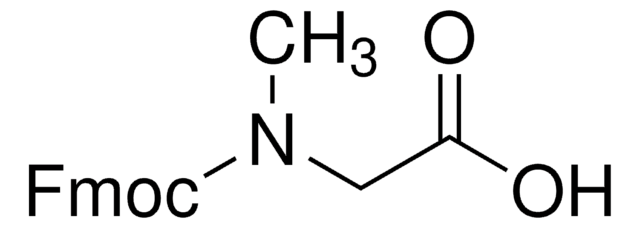おすすめの製品
アッセイ
≥80.0% (degree of coupling)
溶解性
DMF: 0.25 mg/mL, clear
蛍光検出
λex 552 nm; λem 584 nm±10 nm in PBS, pH 7
保管温度
−20°C
詳細
Absorption Maximum, λmax: 231, 308, 350 nm (non-activated, PBS, pH 7.4)
552 nm (photoactivated, PBS, pH 7.4)
Extinction Coefficient, ε(λmax): 66,000 M-1cm-1 (photoactivated, PBS, pH 7.4)
Fluorescence Maximum, λfl: 574 nm (photoactivated, PBS, pH 7.4)
Photoactivation Wavelength:360 - 440 nm
Recommended STED Wavelength, λSTED: 650 − 670 nm
Fluorescence Quantum Yield, η: 0.37 (after photoactivation, PBS, pH 7.47)
552 nm (photoactivated, PBS, pH 7.4)
Extinction Coefficient, ε(λmax): 66,000 M-1cm-1 (photoactivated, PBS, pH 7.4)
Fluorescence Maximum, λfl: 574 nm (photoactivated, PBS, pH 7.4)
Photoactivation Wavelength:360 - 440 nm
Recommended STED Wavelength, λSTED: 650 − 670 nm
Fluorescence Quantum Yield, η: 0.37 (after photoactivation, PBS, pH 7.47)
アプリケーション
- Abberior® CAGE 552 has been conjugated with secondary anti-guinea pig antibody for PALM (photo-activated light microscopy) imaging in MDA-MB-468 and COS-7 cells.
- It has been labelled with secondary antibody to perform dSTORM (direct stochastical optical reconstruction microscopy) for localization of deposited callose in destained Arabidopsis thaliana leaves.
- Abberior® CAGE 552 goat anti-mouse antibody has been used for FPALM (fluorescence photoactivation localization microscopy) imaging in NIH-3T3 fixed cells.
- It has been used for PALM imaging of silica colloids.
- It has also been used for PALM imaging of functionally asymmetric GPCR (G protein-coupled receptor) oligomers.
適合性
Designed and tested for fluorescent super-resolution microscopy
法的情報
abberior is a registered trademark of Abberior GmbH
保管分類コード
11 - Combustible Solids
WGK
WGK 3
引火点(°F)
Not applicable
引火点(℃)
Not applicable
適用法令
試験研究用途を考慮した関連法令を主に挙げております。化学物質以外については、一部の情報のみ提供しています。 製品を安全かつ合法的に使用することは、使用者の義務です。最新情報により修正される場合があります。WEBの反映には時間を要することがあるため、適宜SDSをご参照ください。
Jan Code
94822-1MG:
94822-1MG-BULK:
試験成績書(COA)
製品のロット番号・バッチ番号を入力して、試験成績書(COA) を検索できます。ロット番号・バッチ番号は、製品ラベルに「Lot」または「Batch」に続いて記載されています。
Antonio Aloi et al.
Journal of the American Chemical Society, 138(9), 2953-2956 (2016-02-18)
The introduction of super-resolution fluorescence microscopy (SRM) opened an unprecedented vista into nanoscopic length scales, unveiling a new degree of complexity in biological systems in aqueous environments. Regrettably, supramolecular chemistry and material science benefited far less from these recent developments.
Kim C Jonas et al.
The Journal of biological chemistry, 290(7), 3875-3892 (2014-12-18)
Formation of G protein-coupled receptors (GPCRs) into dimers and higher order oligomers represents a key mechanism in pleiotropic signaling, yet how individual protomers function within oligomers remains poorly understood. We present a super-resolution imaging approach, resolving single GPCR molecules to
Steven J Tobin et al.
PloS one, 9(2), e87225-e87225 (2014-02-08)
Ethanol affects the signaling of several important neurotransmitter and neuromodulator systems in the CNS. It has been recently proposed that ethanol alters the dynamic lateral organization of proteins and lipids in the plasma membrane, thereby affecting surface receptor-mediated cellular signaling.
Michael J Mlodzianoski et al.
PloS one, 11(3), e0147506-e0147506 (2016-03-24)
Localization microscopy can image nanoscale cellular details. To address biological questions, the ability to distinguish multiple molecular species simultaneously is invaluable. Here, we present a new version of fluorescence photoactivation localization microscopy (FPALM) which detects the emission spectrum of each
Dennis Eggert et al.
Scientific reports, 4, 4159-4159 (2014-02-25)
Successful defence of plants against colonisation by fungal pathogens depends on the ability to prevent initial penetration of the plant cell wall. Here we report that the pathogen-induced (1,3)-β-glucan cell wall polymer callose, which is deposited at sites of attempted
ライフサイエンス、有機合成、材料科学、クロマトグラフィー、分析など、あらゆる分野の研究に経験のあるメンバーがおります。.
製品に関するお問い合わせはこちら(テクニカルサービス)